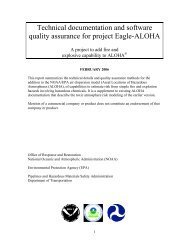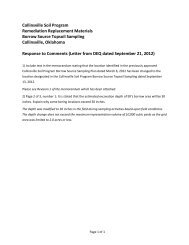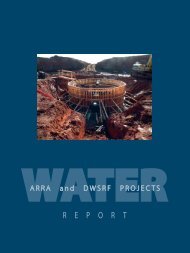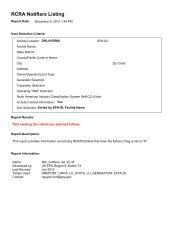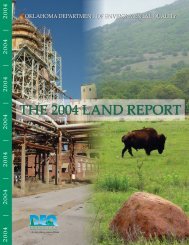Oklahoma Gas & Electric Muskogee Generating Station Best ...
Oklahoma Gas & Electric Muskogee Generating Station Best ...
Oklahoma Gas & Electric Muskogee Generating Station Best ...
Create successful ePaper yourself
Turn your PDF publications into a flip-book with our unique Google optimized e-Paper software.
<strong>Oklahoma</strong> <strong>Gas</strong> & <strong>Electric</strong><br />
<strong>Muskogee</strong> <strong>Generating</strong> <strong>Station</strong> – BART Determination<br />
May 28, 2008<br />
(1) costs of compliance;<br />
(2) energy impacts; and<br />
(3) non-air quality environmental impacts.<br />
Costs of Compliance<br />
The economic analysis performed as part of the BART determination examines the costeffectiveness<br />
of each control technology, on a dollar per ton of pollutant removed basis.<br />
Annual emissions using a particular control device are subtracted from baseline emissions<br />
to calculate tons of pollutant controlled per year. Annual costs are calculated by adding<br />
annual operation and maintenance costs to the annualized capital cost of an option. Cost<br />
effectiveness ($/ton) of an option is simply the annual cost ($/yr) divided by the annual<br />
pollution controlled (ton/yr).<br />
In addition to the cost effectiveness relative to the base case, the incremental costeffectiveness<br />
to go from one level of control to the next more stringent level of control may<br />
also be calculated to evaluate the cost effectiveness of the more stringent control.<br />
Energy Impact Analysis<br />
The energy requirements of a control technology should be examined to determine whether<br />
the use of that technology results in any significant or unusual energy penalties or benefits.<br />
Two forms of energy impacts associated with a control option can normally be quantified.<br />
First, increases in energy consumption resulting from increased heat rate may be shown as<br />
total Btu’s or fuel consumed per year or as Btu’s per ton of pollutant controlled. Second,<br />
the installation of a particular control option may reduce the output and/or reliability of<br />
equipment. This reduction would result in decreased electricity available to the power grid<br />
and/or increased fuel consumption due to use of less efficient electrical and steam<br />
generation methods.<br />
Non-Air Quality Environmental Impact Analysis<br />
The primary purpose of the environmental impact analysis is to assess collateral<br />
environmental impacts due to control of the regulated pollutant in question. Environmental<br />
impacts may include solid or hazardous waste generation, discharges of polluted water<br />
from a control device, increased water consumption, and land use impacts from waste<br />
disposal.<br />
7



